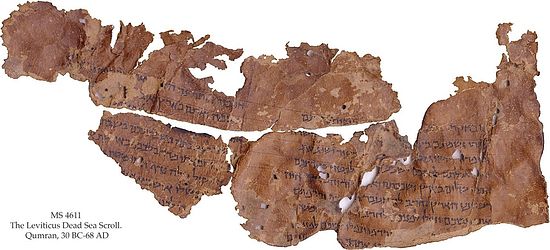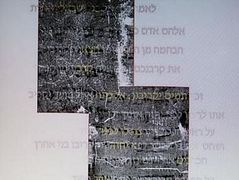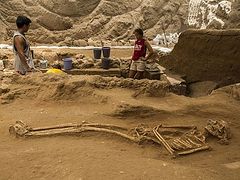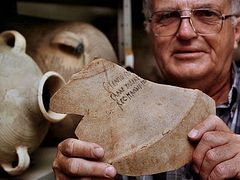Source:Live Science
October 13, 2016
 This scroll fragment preserves parts of the Book of Leviticus, in which God promises to reward the people of Israel if they observe the Sabbath and obey the 10 commandments. Credit: copyright The Schøyen Collection, Oslo and London, MS 4611
This scroll fragment preserves parts of the Book of Leviticus, in which God promises to reward the people of Israel if they observe the Sabbath and obey the 10 commandments. Credit: copyright The Schøyen Collection, Oslo and London, MS 4611
More than 25 previously unpublished "Dead Sea Scroll" fragments, dating back 2,000 years and holding text from the Hebrew Bible, have been brought to light, their contents detailed in two new books.
The various scroll fragments record parts of the books of Genesis, Exodus, Leviticus, Deuteronomy, Samuel, Ruth, Kings, Micah, Nehemiah, Jeremiah, Joel, Joshua, Judges, Proverbs, Numbers, Psalms, Ezekiel and Jonah. The Qumran caves ― where the Dead Sea Scrolls were first discovered ― had yet to yield any fragments from the Book of Nehemiah; if this newly revealed fragment is authenticated it would be the first.
Scholars have expressed concerns that some of the fragments are forgeries. [See Photos of the Dead Sea Scrolls Fragments]
These 25 newly published fragments are just the tip of the iceberg. A scholar told Live Science that around 70 newly discovered fragments have appeared on the antiquities market since 2002. Additionally, the cabinet minister in charge of the Israel Antiquities Authority (IAA), along with a number of scholars, believes that there are undiscovered scrolls that are being found by looters in caves in the Judean Desert. The IAA is sponsoring a new series of scientific surveys and excavations to find these scrolls before looters do.
The Dead Sea Scrolls
The Dead Sea Scrolls were discovered between 1947 and 1956 in a series of 11 caves by the archaeological site of Qumran in the Judean Desert, near the Dead Sea. During that time, archaeologists and local Bedouins unearthed thousands of fragments from nearly 900 manuscripts.
Some of the Bedouin sold their scrolls in Bethlehem through an antiquities dealer named Khalil Iskander Shahin, who went by the name "Kando." Shahin died in 1993 and his son William Kando now runs his business and estate.
Many scholars believe that the Dead Sea Scrolls were hidden in the Qumran caves around A.D. 70, during a Jewish revolt against the Roman Empire. They may have been written by a Jewish sect known as the Essenes.
Qumran and its caves are located in the West Bank, a territory captured by Israel from Jordan during the Six-Day War in 1967. Jordan at times has asserted that the Dead Sea Scrolls belong to them.
Although the term Dead Sea Scrolls usually refers to the scrolls found at Qumran, there have been scrolls found in caves at other sites in the Judean Desert that are considered Dead Sea Scrolls.
Collecting scrolls
The 25 newly published scroll fragments were purchased by two separate collectors. [Gallery of Dead Sea Scrolls: A Glimpse of the Past]
Between 2009 and 2014, Steve Green, the owner of Hobby Lobby, a chain of arts and crafts stores, purchased 13 of the fragments, which he has donated, along with thousands of other artifacts, to the Museum of the Bible. Green is helping to fund construction of the museum, scheduled to open in Washington, D.C., next fall. (A fly-through of the museum can be seen on YouTube).
A team of scholars has published details of these donated fragments in the book volume "Dead Sea Scrolls Fragments in the Museum Collection" (Brill, 2016).
The provenance of this batch of scrolls is not certain.
"Some of these fragments must have come from Qumran, probably Cave 4, while the others may have derived from other sites in the Judean Desert," wrote Emanuel Tov, a professor at the Hebrew University of Jerusalem, in the book volume. "Unfortunately, little is known about the provenance of these fragments because most sellers did not provide such information at the time of the sale."
Antiquities dealer William Kando told Live Science that he doesn't know where the donated fragments originated.
Scientists are conducting tests on the donated fragments to help determine if any are forgeries, said Michael Holmes, executive director of the Museum of the Bible Scholars Initiative, in a statement sent to Live Science.
The results will be combined with an analysis of the writing to help determine what the chances are of the different fragments being forgeries.
"The results will be incorporated in our future museum exhibits, inviting visitors to grasp and engage with issues involved with assessing authenticity," Holmes said.
Biblical manuscripts
Martin Schøyen, a collector from Norway, owns the other batch of the recently revealed Dead Sea Scrolls. The texts from those fragments are detailed in the book "Gleanings from the Caves: Dead Sea Scrolls and Artefacts from The Schøyen Collection" (Bloomsbury, 2016). Also detailed in the book are other artifacts related to the scrolls, including a linen wrapper in which one of the Dead Sea Scrolls was found. [Photos: Who 'Penned' the Dead Sea Scrolls?]
Schøyen, who has a vast collection of antiquities, began collecting biblical manuscripts in 1986. "The ultimate challenge had become to acquire a fragment of the Dead Sea Scrolls with a biblical text," Schøyen wrote in the book. "It was for me a 'Mission: Impossible.'"
His determination paid off as, gradually, he was able to track down scroll fragments that were for sale by a number of sources. He bought several from a family collection that is now in in Zurich (the name was not published) and several more from the descendants of tourists or collectors who had purchased scrolls from Shahin's shop in Bethlehem in the 1950s. He also purchased a few fragments that were once owned by two scholars who had worked in the Qumran caves as students in 1948 (the students got the fragments as gifts from a bishop who supported the work).
"The quest that started as a 'Mission: Impossible' in 1986, gradually proceeded to become a collection of [about] 115 fragments from around 27 different scrolls," Schøyen said. He added that some of the fragments in his collection come from caves 1, 4 and 11 at Qumran, while some come from other caves in the Judean Desert.
Nehemiah
A highlight from the newly published Museum of the Bible collection is a fragment from the Book of Nehemiah (Nehemiah 2:13-16).
The fragment tells of a man named Nehemiah who lived during the fifth century B.C., at a time after Jerusalem had been destroyed by the Babylonians in 586 B.C. The Persian Empire had taken over Babylon's territory and the Jews, who had been forced to leave Israel by the Babylonians, were allowed to return home.
The fragment records Nehemiah's visit to a ruined Jerusalem, finding that its gates had been "consumed by fire." According to the fragment text, he inspects the remains of the walls before starting work on rebuilding them.
Scholars have noted in previous studies that archaeologists hadn't found any copies of the Book of Nehemiah in the Qumran caves. How this fragment came to America is unknown, and scholars say they can't be sure it's from Qumran.
"It is assumed to come from Cave 4 [at Qumran], but in the final analysis it must be said that the provenance of the fragment remains unknown," wrote Martin G. Abegg Jr., a professor at Trinity Western University who led the team that analyzed the fragment, in the book "Dead Sea Scrolls Fragments in the Museum Collection."
Leviticus
A highlight from the Schøyen Collection is a fragment containing part of the Book of Leviticus. In the fragment text, God promises that if the Sabbath is observed and the Ten Commandments are obeyed, the people of Israel will be rewarded.
"If you walk according to my laws, and keep my commandments and implement them, then I will grant your rains in their season, so that the earth shall yield its produce and the trees of the field their fruit," part of the fragment reads (translation by Torleif Elgvin).
"I will grant peace in the land, and you shall lie down untroubled by anyone; and I will exterminate vicious beasts from the land, and no sword shall cross your land," the fragment continues. "I will look with favour upon you, and make you fertile and multiply you."
Schøyen published a note from William Kando saying that the Leviticus scroll fragment was once owned by his father who got it from Bedouin in 1952 or 1953 and it was sold, along with other fragments, to a customer in Zurich in 1956.



